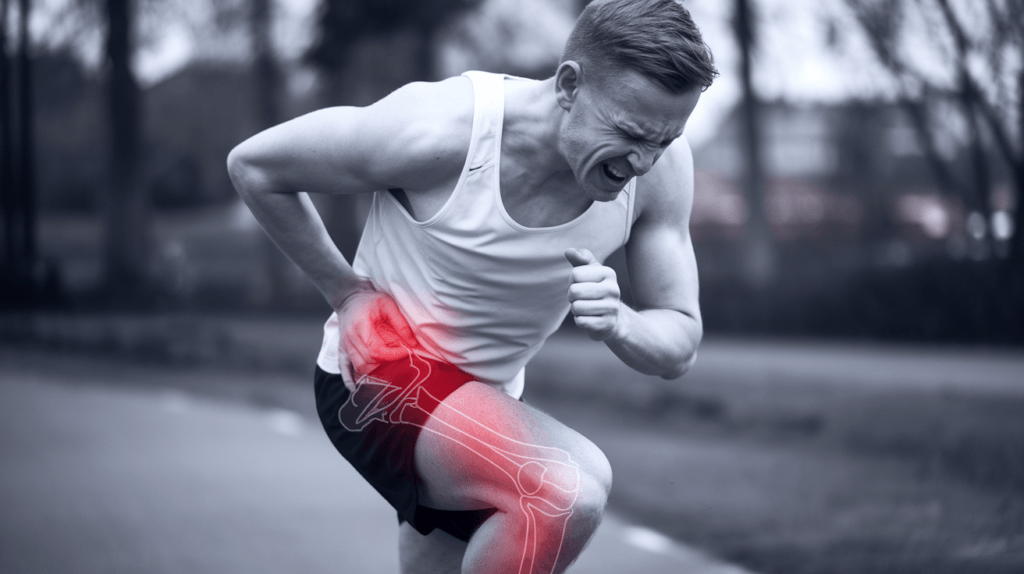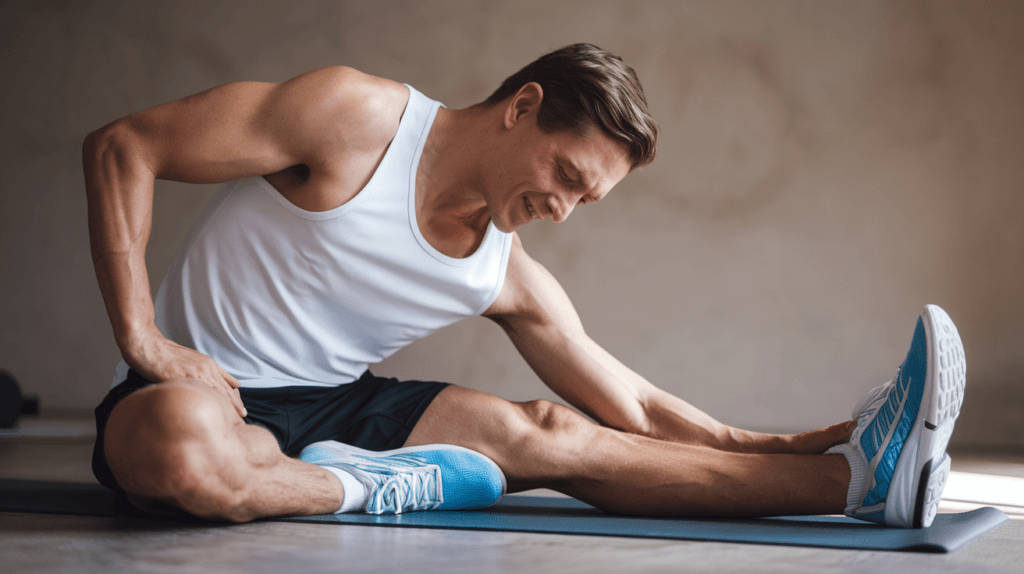Are you a runner plagued by persistent hip pain? You’re not alone. Many runners experience this frustrating issue, which can sideline even the most dedicated athletes. But why does it happen, and more importantly, how can you overcome it?
Hip pain in runners is a complex problem with various potential causes. From muscle imbalances to overuse injuries, the reasons behind your discomfort might surprise you. Understanding these root causes is the first step towards pain-free running and getting back to doing what you love.
In this comprehensive guide, we’ll explore the common causes of hip pain in runners, help you recognize the symptoms, and provide insights into effective treatments and prevention strategies. Whether you’re a seasoned marathoner or a casual jogger, this information will empower you to take control of your running health and keep your hips happy. Let’s dive in and uncover the mysteries behind runner’s hip pain!
What is Runners Hip Pain And What Cause It?
Understanding Hip Pain in Runners
Hip pain in runners refers to discomfort or aching sensations experienced in the hip area during or after running. This common issue can affect runners of all levels, from beginners to seasoned athletes. The hip joint is a complex structure that bears significant weight and stress during running, making it susceptible to various injuries and conditions.

Causes of Hip Pain in Runners
Several factors can contribute to hip pain in runners:
- Overuse and repetitive stress
- Muscular imbalances
- Poor running form
- Inadequate warm-up or cool-down
- Inappropriate footwear
- Sudden increase in training intensity or volume
Common Hip Pain Conditions in Runners
| Condition | Description | Common Symptoms |
|---|---|---|
| IT Band Syndrome | Inflammation of the iliotibial band | Pain on the outside of the hip or knee |
| Hip Bursitis | Inflammation of the bursa sacs | Pain on the outside of the hip, especially when lying on the affected side |
| Hip Flexor Strain | Overuse or tearing of hip flexor muscles | Pain in the front of the hip or groin area |
| Labral Tear | Damage to the cartilage ring in the hip socket | Deep ache in the hip or groin, clicking sensation |
Understanding the underlying causes of hip pain is crucial for proper diagnosis and treatment. Runners experiencing persistent hip pain should consult a healthcare professional for an accurate assessment and tailored treatment plan. With this understanding of hip pain and its causes, let’s explore the common causes in more detail.
Muscle Imbalances and Weakness
Muscle imbalances and weakness in the hip area can contribute significantly to hip pain in runners. Common issues include:
- Weak gluteal muscles
- Tight hip flexors
- Imbalanced quadriceps and hamstrings
These imbalances can alter running biomechanics, leading to increased stress on the hip joint.
How do I recognise the symptoms?
Identifying Hip Pain Symptoms in Runners

Common Signs and Symptoms
Recognizing symptoms early is crucial for runners to prevent further injury and maintain their training routine. Here are the most common signs to watch out for:
- Sharp or dull pain in the hip area
- Stiffness or reduced range of motion
- Clicking or popping sensations
- Pain that worsens with activity
- Discomfort while sitting or lying down
Location-Specific Symptoms
The location of hip pain can often indicate its underlying cause:
| Pain Location | Possible Cause |
|---|---|
| Front of hip | Hip flexor strain or iliopsoas tendinitis |
| Side of hip | IT band syndrome or trochanteric bursitis |
| Back of hip | Piriformis syndrome or hamstring tendinopathy |
| Groin area | Adductor strain or labral tear |
Symptom Progression
Hip pain symptoms in runners typically follow a pattern:
- Initial discomfort during or after running
- Pain that lingers post-exercise
- Difficulty with daily activities
- Altered running gait or compensatory movements
It’s important to note that hip pain can sometimes be referred pain from other areas, such as the lower back or knee. If symptoms persist or worsen, consulting a sports medicine professional is advisable for an accurate diagnosis and appropriate treatment plan.
What does hip pain feel like when running?

Characteristics of Hip Pain During Running
Hip pain while running can manifest in various ways, depending on the underlying cause. Here are the common sensations runners might experience:
- Sharp, stabbing pain
- Dull ache or throbbing
- Burning sensation
- Tightness or stiffness
Location and Timing of Pain
The location and timing of hip pain can provide valuable insights into its cause:
| Location | Possible Cause | Timing |
|---|---|---|
| Outer hip | IT band syndrome | During or after running |
| Groin area | Hip flexor strain | When lifting the knee |
| Deep in the joint | Hip bursitis | Worse after sitting |
| Buttocks | Piriformis syndrome | Radiating down the leg |
Impact on Running Performance
Hip pain can significantly affect a runner’s performance and technique:
- Altered gait or limping
- Reduced stride length
- Decreased running speed
- Difficulty maintaining proper form
Associated Symptoms
Runners experiencing hip pain may also notice:
- Swelling or inflammation around the hip joint
- Stiffness, especially in the morning or after sitting
- Clicking or popping sensations
- Referred pain in the lower back or knee
Understanding these sensations and symptoms is crucial for identifying the root cause and seeking appropriate treatment. If you’re experiencing persistent hip pain while running, it’s essential to consult with a healthcare professional or sports medicine specialist for a proper diagnosis and tailored treatment plan.
How can it be treated?
Rest and Recovery

Treating hip pain in runners often begins with rest and recovery. This crucial step allows the affected area to heal and reduces inflammation. Here’s a breakdown of effective rest strategies:
| Rest Strategy | Duration | Benefits |
|---|---|---|
| Complete Rest | 2-3 days | Immediate pain relief |
| Active Rest | 1-2 weeks | Maintains fitness while healing |
| Cross-training | 2-4 weeks | Strengthens supporting muscles |
Physical Therapy
Physical therapy plays a vital role in treating hip pain from running. A qualified therapist can:
- Assess your running biomechanics
- Provide targeted exercises to strengthen hip muscles
- Teach proper stretching techniques for hip flexors and IT band
Home Remedies
Runners can implement several home remedies to alleviate hip pain:
- Ice therapy: Apply ice for 15-20 minutes every 2-3 hours
- Heat therapy: Use after 48-72 hours to increase blood flow
- Foam rolling: Target the IT band and hip flexors
- Gentle stretches: Focus on hip flexors, piriformis, and glutes
Medication and Professional Treatment
For persistent hip pain, consider:
- Over-the-counter anti-inflammatory drugs (NSAIDs)
- Corticosteroid injections for severe cases
- Consultation with a sports medicine specialist
Now that we’ve covered treatment options, let’s explore preventive measures to keep hip pain at bay while running.
What are the best prevention measures?
Strengthen Your Hip Muscles
One of the most effective ways to prevent hip pain while running is to strengthen the muscles around your hips. Focus on exercises that target your hip flexors, glutes, and core. Incorporate these exercises into your routine:
- Clamshells
- Bridges
- Side-lying leg lifts
- Single-leg squats
Improve Your Running Form
Proper running technique can significantly reduce the risk of hip pain. Pay attention to:
- Maintaining a neutral pelvis
- Avoiding overstriding
- Keeping your cadence high (around 170-180 steps per minute)
Incorporate Dynamic Stretching
Before your runs, perform dynamic stretches to warm up your hip muscles:
- Walking lunges
- Leg swings (front to back and side to side)
- Hip circles
- Butt kicks
Cross-Train and Rest
Balancing your running with other activities can help prevent overuse injuries:
| Activity | Benefits |
|---|---|
| Swimming | Low-impact cardio, works different muscle groups |
| Cycling | Strengthens leg muscles without impact stress |
| Yoga | Improves flexibility and core strength |
Gradually Increase Mileage
Follow the 10% rule: don’t increase your weekly mileage by more than 10% at a time. This allows your body to adapt to the increased workload without overstraining your hips.
Invest in Proper Footwear
Choose running shoes that provide adequate support and cushioning for your foot type and running style. Replace them every 400-500 miles to ensure they maintain their supportive properties.

Now that you’re equipped with these prevention strategies, let’s explore how to effectively treat hip pain if it does occur.
Conclusion
Hip pain can be a frustrating obstacle for runners, but understanding its causes and symptoms is the first step towards effective treatment and prevention. From overuse injuries to muscle imbalances, various factors can contribute to hip discomfort during and after running. By recognizing the signs early and addressing the underlying issues, runners can take proactive steps to maintain their hip health and continue enjoying their favorite activity.

Remember, prevention is key when it comes to hip pain. Incorporating proper warm-up routines, strength training exercises, and regular stretching into your fitness regimen can significantly reduce the risk of developing hip issues. If you do experience persistent hip pain, don’t hesitate to consult with a healthcare professional or sports medicine specialist. With the right approach and care, you can keep your hips healthy and your running goals on track.

